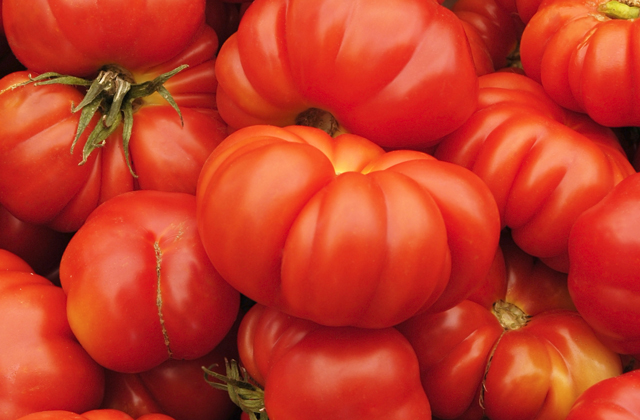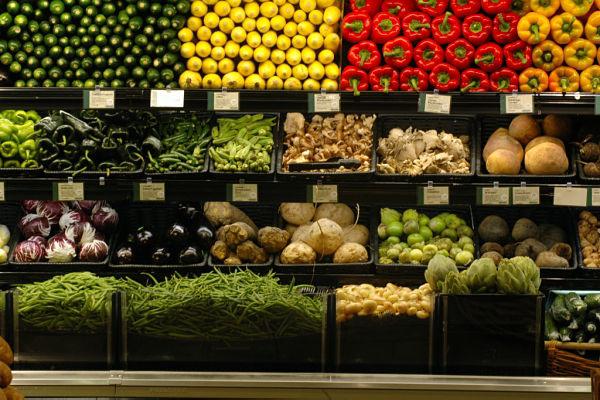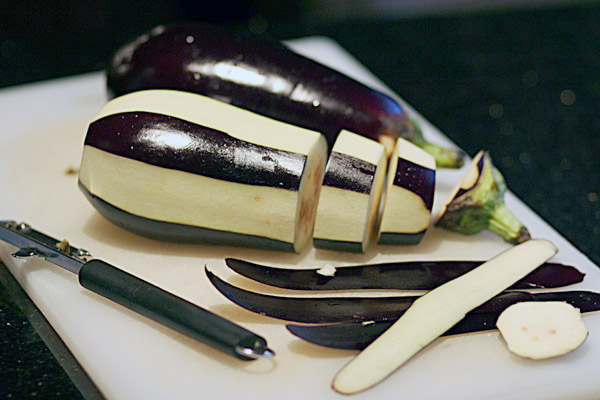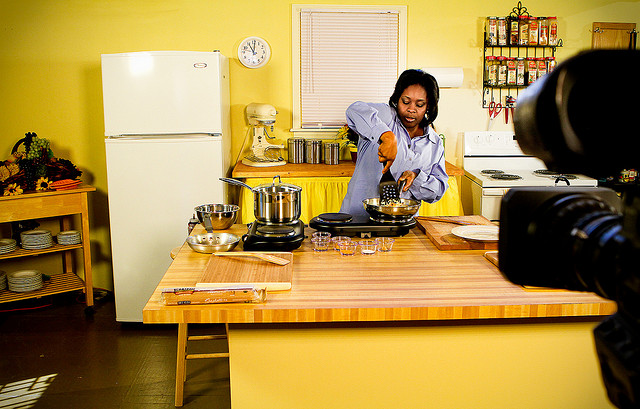Published on http://dandelionsalad.wordpress.com

My maternal grandmother grew tomato plants in huge coffee cans on a rooftop veranda in Brooklyn. Before that in a town called Patti (Greek for “on the shore”) on the Bay of Patti in Sicily, she made bread for the burgher class and pastries for the Baron and his family, a Sicilian version of Downton Abbey. The “contadini” made their own bread. She owned a filbert grove (nocciolanoc; namesd after St. Philibert whose feast day coincided with the ripening of the nut) and fed a neighbor’s hog which she received half of at butchering time. She made sausage (sweet fennel & parsley and pecorino) which she hung from the rafters in the attic, joining herbs like oregano, rosemary, basil, sage, to dry, where it would dry nicely as did the tomatoes she laid out in screens in the sun and brought inside in the evening. I marvelled then as a boy at how many delicious tomatoes were picked from a few coffee can tomato plants, a sweet, plum variety that in the U.S. would give way to our “industrial strength,” gassed with ethylene to turn them red, tasteless Romas.
I’ve used Grandmother Tindara’s bread recipe (hard crusted round Sicilian with sesame seeds) with me as I moved around the country. I carry in my genes also an instinctual need to plant, to put seeds in the ground come Spring.
In the beginning of what turned out to be a live for awhile tour around the U.S., I met a former chef from the Boston Ritz Carleton whose own family had been “truck” farmers and mushroom growers. We planted a half acre garden in New Hampshire for a few years and from Larry I learned that you can grow tasty, healthy stuff without chemicals or pesticides. Rachel Carson had been a big influence on his view of what later grew to be our country’s ecological concerns.
Although Larry hadn’t cooked “out of the garden” Alice Waters style at the Ritz Carleton, that was the way he cooked for himself and his friends. A 7PM dinner invitation at Larry’s up on Bear Hill Road meant that when you arrived you were prepared to go out into the garden, pick under Larry’s orders what was ready to pick, come back inside to Larry’s ship galley-like kitchen with every pot, pan and utensil hanging from the ceiling, and then become a sous chef to Larry, cleaning, peeling, slicing, chopping the harvest.
We generally didn’t sit down to eat until about 11PM. Larry still had ties with wine merchants in Boston’s North End, where the two of us would go into the backrooms and sample what Larry called “dinner palatable wine at a good price.” When he found it, he would buy cases so our dinners, heated by such wine and the heavenly bliss of Larry’s cooking, rollicked on until very late. There was always a moment when Larry would sit back and say, “Anyone for dessert? What do we want to make?”
We always waited for this but we were all smart enough not to give advise but simply encourage him to follow his genius. We, of course, followed him into the kitchen to watch. As long as we stayed out of his way, as he gazed up at his tools hanging from the ceiling, then studied our fresh pickings and then had his “Eureka!” moment and began to give orders to his guest-workers (Larry believed “to each according to his work” and that included dinner guests), who once again his sous chefs.
I continue after so many years to cook this way, out of my garden, but I am less demanding of my guests at a time now where the brand of cooperative anarchism Larry and I subscribed to has been coopted by a very capitalist/competitive friendly Libertarianism. The guy who “loses” cooks, serves and washes the dishes.
We had thought of opening a restaurant (Alice Waters was having the same thoughts on the West Coast at that time) but it never came to pass. We could never afford a location we needed, a location where our diners had an appreciation for what we were about. As the heart of both our cooking was southern European and therefore “foreign” to much of the American palette from New England (where we were at the time) to the South, the Midwest and the Far West, venue was crucial. We were all about what was called then “European peasant” cooking (later to be lauded as a healthy “Mediterranean diet” featuring olive oil, garlic, tomatoes, leafy greens such as augula, balsamico, fennel, radicchio, beans and legumes, fruit, nuts, red wine and so on.
Southern European “home cooking,” as say in France, took a (downward) path from the canons of French cookery, handed down from Napoleon’s chef Marie-Antoine Carême to Auguste Escoffier to the tweezered minimalism of today. Escoffier in the 20th century created a “haut cuisine” which added truffles, sauces a la creme and fois gras and such to provincial French cuisine bourgeoise and also “nationalized” and under-represented regional differences. But foundations remained solid, peasant fare, such as cassoulet, pot au feu, confit du canard, coq au vin, vichysoisse. Fernand Point and his student Paul Bocuse, returned to regional cooking and in what became a late 1960′s reincarnation of “nouvelle cuisine,” lightened and freshened the older cuisine classique. It was “nouvelle cuisine,” however, that began a “gentrification” of food insofar as it valued the discipline and restraint — tiny, tweezered portions framed on an expanse of white plate — which Pierre Bourdieu, the cultural critic, had defined in his book La Distinction as what reveals civilization, culture, and order.
Opposed to this “nouvelle cuisine” was an overflowing dish of spaghetti, which signified appetites beyond rational, disciplined, civilized control. Read “Italian cuisine” and “Italian eaters.” Le Cuisinier françois (1652) by La Varenne, one of France’s greatest chefs learned to cook in Marie De Médicis kitchens and thus began that “anxiety of Italian culinary influence” that has tormented the French soul. Their roots are Italian. And while the French have progressively moved toward a “distinction” as Bourdieu defines it, the Italians have not gone down that path. Both, however, have melded within a southern California culinary imaginary into an amorphous, elastic “Mediterranean” cuisine which includes everything from Toulouse to Istanbul.
“Nouvelle cuisine” grounded itself in class difference in a way that the older cuisine had not, although we tend to associate the “old” with privilege elitism and the new with an egalitarian democratization. Such is not the case with French food. Nor is it the case with the U.S. as a whole. Ask a former member of the middle class or a rent controlled apartment in a city who finds himself out on the street and his apartment building “re-gentrified.”
What we see now on “Food TV” is a combination of the Alpha-competitiveness of combative Reality TV cooking “challenges” that accompany “Let Markets Rule!”; a cockamammy, disrespectful mishmash of all regional cuisine orchestrated by the genius of “personal design,” also a darling of “Let Markets Rule!” and the sort of tweezer and magnifying class assemblage work more suited for putting together a ship in a wine bottle than for cooking. In this manner, food and cooking have been gentrified to meet the needs of a plutocracy, of the Haves and those dying to be, sometimes literally.
To say that food and cooking have been “re-gentrified” is a politeness, rather like saying your friend must “re-read” Plato, though it’s clear he never read him in the first place. There is much that is being “re-gentrified” in the U.S. right now, as the wealthy move into places and domains that now appeal to them, as they increasingly “privatize” what before was “public.”
My home borough, the “Borough of Churches,” fast becoming the “Borough of the Gentrified,” Brooklyn, was always destined, I suppose, to be “re-gentrified” by wealthy Manhattanites.
If you’ve seen the film The Big Night, 1996 (and if you haven’t, you should), the dilemma that Tony Shaloub faced was Larry’s and mine way back then in the early `70s. In that movie, Shalhoub, a chef who does not compromise on his cooking, faces a diner who demands meatballs with her risotto. Shalhoub explains that his risotto stands alone; there is no “side” of meatballs. His brother, played by Stanley Tucci, is all business: “Give the customer what the customer wants.” Shalhoub stands fast and, of course, the restaurant is doomed to failure.
That film came out many years after Larry and I decided that we need to be in a place where diners could experience beyond pizza and spaghetti, beyond tortilla as a Mexican flatbread, creme caramel or creme brulee, beyond Ranch Dressing, salad “bars,” encyclopedic menus in which everything is fresh and ready to go. We needed a locale, actually a world, that would accept our “if it’s seasonal, we cook it” menu, a menu of no more than three choices (we weren’t magicians and even if microwaves had been invented, we wouldn’t have used them), a menu in which no dish relied on a bottled or canned or frozen anything, or a “squeeze bottle,” a menu in which the integrity of the region where it had been created was preserved and no “customer choice” could trump that.
Of course, we would have gone The Big Night way. We would have eventually had to put out sides of fries, no dark leafy greens, bottled dressings, salad bars and so on.
We were facing back then a growing American preference for franchised, “fast food” emporiums. Carlo Petrini’s “Slow Food” and the “Local Food” movements were not even on the horizon, but McDonalds was boasting “billions served.” If we had a lot of start up money, we could have found a venue among the always-already gentrified rich, the ones whose palettes had been taken around the world thanks to their “will to win” or their “birthrights.”
As both Larry and I spoke, taught and wrote about how economic inequality might do some harm to our democracy, we were not keen on setting up shop, even if we could afford, among the entitled. And the movement toward tweezered assemblages centered on the tabula rasa of white plate did not then, nor does it now to me, signify civilization.
What will farming, gardening, food, cooking and dining be like in our coming middle ages? Gulliver has to travel to that.












